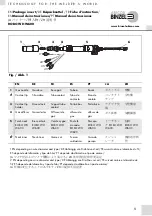
Glossar
Glossar
A-law
µ-law
Das
A-law
-Verfahren
ist ein primär in
Europa verwendetes Digitalisierungs-
verfahren für analoge Audiosignale
im
Telekommunikationsbereich, das in
der Empfehlung G.711 der ITU-T
stan-
dardisiert ist. Dabei werden analoge
Sprachsignale im
Rahmen der
Digitali-
sierung
mittels einer nichtlinea-
ren
Quantisierungskennlinie, der so
genannten A-Kennlinie, in digitale Sig-
nale
umgewandelt. Ziel ist bei gleicher
binärer Stellenanzahl pro Abtastwert
einen höheren Dynamikumfang bzw.
ein größeres Signal-Rausch-Verhält-
nis
zu erzielen, in dem große Signal-
auslenkungen gröber und kleine Sig-
nalauslenkungen feiner aufgelöst
werden.
In Nordamerika und Japan wird das
ähnliche
µ-law
-Verfahren eingesetzt,
das dem A-law ähnelt, jedoch nicht
kompatibel ist.
Baud-
rate
beschreibt die Anzahl der übertragenen
Symbole pro Zeiteinheit. Die Baudrate
unterscheidet sich von der geringeren
Datenrate durch das Verhältnis der
Anzahl der Symbole pro übertragenem
Nutzbit. Die Baud-rate muss bei einer
Kommunikation über eine serielle
Schnittstelle auf beiden Seiten gleich
eingestellt sein.
DHCP
D
ynamic
H
ost
C
onfiguration
P
rotocol -
ermöglicht die Zuweisung der Netz-
werkkonfiguration an Geräte durch
einen DHCP-Server. Bei dieser Einstel-
lung muss der Benutzer die IP-Adresse
und andere Adressen nicht manuell
einstellen.
DNS
D
omain
N
ame
S
ystem - Dienst im
Netzwerk, hauptsächlich zur Beantwor-
tung von Anfragen zur Namensauflö-
sung. Dadurch können Geräte mit ei-
nem Klartextnamen angesprochen
werden, der sich leichter merken lässt
und das Gerät charakterisiert. Dabei
bleibt der Name auch bei wechselnden
IP-Adressen stets gleich.
Glossary
Glossary
A-law
µ-law
The A-law is a method of digitization
pro-cess for analog audio signals in the
telecommunications sector used pri-
marily in Europe, which is standardized
in the re-commendation G.711 by the
ITU-T. By this, analog voice signals are
converted through the digitization with
a non-linear quantization, the so-called
A-characteristic curve, into digital sig-
nals. The aim is to achieve a higher
dynamic range with the same number
of binary digits per sample or a larger
signal-to-noise ratio, in which the large
signal excursions have coarser and
small signal excursions have finer reso-
lutions.
In North America and Japan, the
μ
-law-
related method is used, similar to the
A-law, but not compatible.
Baud-
rate
describes the number of symbols
transmitted per time unit. The baud
rate is different from the lower data
rate by the ratio of the number of sym-
bols per transmitted data bit. The baud
rate must be set equal on both sides
when communicating via a serial inter-
face.
DHCP
D
ynamic
H
ost
C
onfiguration
P
rotocol -
allows the assignment of the network
configuration to devices by a DHCP
server. In this setting, the user must
not set the IP address and other ad-
dresses by hand.
DNS
D
omain
N
ame
S
ystem - Service on the
network, mainly for responding to re-
quests for name resolution. This device
can be addressed with a plain text
name that is easier to remember and
characterizes the device. Here, the
name remains the same even with
changing IP addresses.
Adatis GmbH & Co. KG
Version 1.000
Seite 23 von 25



































